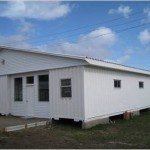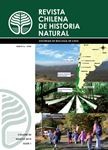 Dr. Andres Mansilla and colleagues at the Universidad de Santiago and the Universidad Arturo Pratt have received a FONDEF Grant (approximately $600,000 USD) from the Chilean Scientific and Technological Research Commission (CONICYT) to study i) the biochemical properties and ii) cultivation techniques of Anfeltia plicata, an important but little known marine algae that can potentially be used as a sustainable alternative for fisherman who currently depend almost exclusively on crab and sea urchins. The grant will also fund the construction of a Sub-Antarctic Seaweed Laboratory (see photo) and co-fund the creation of a Sub-Antarctic Cryptogam Herbarium, which will be used for algae, lichens, liverworts and mosses. As such, the award and Dr. Mansilla’s research will help to promote conservation and sustainable use of sub-Antarctic biodiversity.
Dr. Andres Mansilla and colleagues at the Universidad de Santiago and the Universidad Arturo Pratt have received a FONDEF Grant (approximately $600,000 USD) from the Chilean Scientific and Technological Research Commission (CONICYT) to study i) the biochemical properties and ii) cultivation techniques of Anfeltia plicata, an important but little known marine algae that can potentially be used as a sustainable alternative for fisherman who currently depend almost exclusively on crab and sea urchins. The grant will also fund the construction of a Sub-Antarctic Seaweed Laboratory (see photo) and co-fund the creation of a Sub-Antarctic Cryptogam Herbarium, which will be used for algae, lichens, liverworts and mosses. As such, the award and Dr. Mansilla’s research will help to promote conservation and sustainable use of sub-Antarctic biodiversity.
Category Archives: General
Special Edition of Chilean Natural History Journal Dedicated to LTSER
 Researchers associated with Chile’s first Long-Term Socio-Ecological Research Network, coordinated by the Institute of Ecology and Biodiversity and 5 associated universities and 2 private non-profit organizations, recently launched a special edition of the Revista Chilena de Historia Natural with invited contributions from Chile, Argentina, Mexico, USA and Spain to contextualize and put into value the importance of not only long-term, but integrated social-ecological studies. To enhance the impact of this work, the editors also produced the volume in English and Spanish (click on the original article or the translation as “Material Complementario”). See the journal page to read these important contributions to the debate about LTSER in Chile, the Southern Cone and the world.
Researchers associated with Chile’s first Long-Term Socio-Ecological Research Network, coordinated by the Institute of Ecology and Biodiversity and 5 associated universities and 2 private non-profit organizations, recently launched a special edition of the Revista Chilena de Historia Natural with invited contributions from Chile, Argentina, Mexico, USA and Spain to contextualize and put into value the importance of not only long-term, but integrated social-ecological studies. To enhance the impact of this work, the editors also produced the volume in English and Spanish (click on the original article or the translation as “Material Complementario”). See the journal page to read these important contributions to the debate about LTSER in Chile, the Southern Cone and the world.
Sub-Antarctic Conservation Program Launches Search for Ecosystem Ecologist
 The University of North Texas (UNT: www.unt.edu) seeks a Senior Level Ecosystem Ecologist (rank open, preference full professor) with a Ph.D. in ecology or related field and research and teaching activities in a specific subdiscipline, such as biogeochemistry or similar area, to be part of an interdisciplinary program in Sub-Antarctic Biocultural Research and Conservation (www.chile.unt.edu), focusing on ecology and culture in southern Chile. Coordinated by the Departments of Biological Sciences and Philosophy & Religion Studies, the Program has numerous collaborations, including the Chilean Institute of Ecology and Biodiversity (www.ieb-chile.cl) and the Universidad de Magallanes (www.umag.cl). For posting details and how to apply visit https://facultyjobs.unt.edu/applicants/Central?quickFind=50629. For more information: Dr. Christopher B. Anderson, christopher.anderson@unt.edu. UNT is an AA/ADA/EOE.
The University of North Texas (UNT: www.unt.edu) seeks a Senior Level Ecosystem Ecologist (rank open, preference full professor) with a Ph.D. in ecology or related field and research and teaching activities in a specific subdiscipline, such as biogeochemistry or similar area, to be part of an interdisciplinary program in Sub-Antarctic Biocultural Research and Conservation (www.chile.unt.edu), focusing on ecology and culture in southern Chile. Coordinated by the Departments of Biological Sciences and Philosophy & Religion Studies, the Program has numerous collaborations, including the Chilean Institute of Ecology and Biodiversity (www.ieb-chile.cl) and the Universidad de Magallanes (www.umag.cl). For posting details and how to apply visit https://facultyjobs.unt.edu/applicants/Central?quickFind=50629. For more information: Dr. Christopher B. Anderson, christopher.anderson@unt.edu. UNT is an AA/ADA/EOE.
Cape Horn Setting for BBC Adventure Series
 In December 2007, the BBC adventure series Serious Ocean filmed during a month-long navigation by boat in the Cape Horn Biosphere Reserve. The 10 part program premiered on 16 June 2008 in London amid much fan fare. The 8 young adventurers from 13-15 participated in numerous conservation projects throughout the archipelago, including tagging elephant seals and trapping beavers. The program will air in the U.K. and United States and bring the Cape Horn Biosphere Reserve to millions of homes in the coming year. For the text version of a news clip with Dr. Christopher Anderson that appeared on national television, visit the following link.
In December 2007, the BBC adventure series Serious Ocean filmed during a month-long navigation by boat in the Cape Horn Biosphere Reserve. The 10 part program premiered on 16 June 2008 in London amid much fan fare. The 8 young adventurers from 13-15 participated in numerous conservation projects throughout the archipelago, including tagging elephant seals and trapping beavers. The program will air in the U.K. and United States and bring the Cape Horn Biosphere Reserve to millions of homes in the coming year. For the text version of a news clip with Dr. Christopher Anderson that appeared on national television, visit the following link.
Letter from “Cape Horn” on NPR
Listen to NPR All Things Considered‘s hosts Michele Norris and Robert Siegel read from listeners’ e-mails, including responses to coverage of Super Tuesday, and a series that parsed the candidates’ positions on four major issues.
Also hear one native North Carolinian, living in Cape Horn, reflect on an interview with Franklin McCain, a Greensboro student who protested a whites-only Woolworth lunch counter in 1960.
Cape Horn Research Center – Coming Soon!
 We are very proud to announce that this year our consortium was able to obtain the funding to implement much needed infrastructure in the CHBR. After years of work on this initiative by dedicated individuals, the IEB was able to take the lead in association with UNT and UMAG to obtain a highly prestigious grant, known as Fondos Basales, that together with contributions from the Center for Environmental Philosophy (CEP), UMAG, UNT and OSARA will provide $300,000 dollars to build a guest house-laboratory at the Omora Park.
We are very proud to announce that this year our consortium was able to obtain the funding to implement much needed infrastructure in the CHBR. After years of work on this initiative by dedicated individuals, the IEB was able to take the lead in association with UNT and UMAG to obtain a highly prestigious grant, known as Fondos Basales, that together with contributions from the Center for Environmental Philosophy (CEP), UMAG, UNT and OSARA will provide $300,000 dollars to build a guest house-laboratory at the Omora Park.
This is undoubtedly a major step to ensure the long-term sustainability of our program in Cape Horn. The project will include “bioclimatic” design techniques and efficient energy use, hopefully becoming a model for sustainable construction in the region.
End-of-Year Message from the President
Dear Friends,
The past year has been a busy and productive one in the Cape Horn Biosphere Reserve (CHBR). So, in addition to wishing everyone a Happy New Year, I would like to take a moment, during this season of reflection, to review some of these achievements and offer my sincere thanks to each of you for taking part in our initiative. Your contributions of time, money and effort enable us to continue exploring the biocultural treasures of the Cape Horn Archipelago.
The year started off with a bang in January. Dr. Kurt Heidinger (former OSARA education coordinator) led an intrepid group of 10 students from the University of North Texas (UNT) on the first “field philosophy” course conducted at the Omora Park . The success of Kurt’s program has begotten two more courses in the Tracing Darwin’s Path series for 2008. Dr. Jim Kennedy (OSARA Advisor) was also visiting the Omora Park from UNT in January for a pilot study that has now developed into an aquatic biodiversity assessment of the Robalo Watershed, supported by the Hispanic Global Initiative. This funding will allow students and scientists from UNT and the University of Magallanes (UMAG) to work on this little understood aspect of subantarctic ecology. To coalesce all these activities, UNT has now created a Chile Program Office, directed by Dr. Ricardo Rozzi (OSARA advisor), which works directly with OSARA to plan and execute these Chile-US programs.
Also in the area of education, in March the Institute of Ecology and Biodiversity (IEB), UNT, and UMAG organized the first Latin American graduate-level course and workshop on biocultural conservation and environmental ethics, gathering top students from Chile, Argentina, Peru, Columbia, Mexico, Germany and the US, as well as world experts in ecology, philosophy and public policy from the U.S., Chile, Argentina and Europe. This innovative course and workshop, financed by the Chilean government and the U.S. National Science Foundation, reinforced the leadership role of Cape Horn Biosphere Reserve scientists and academics as pioneers in this new transdisciplinary field and strengthened their call that indeed conservation and human social wellbeing are intrinsically linked!
It is no surprise, then, that the research conducted in the CHBR has received extensive coverage in general media and scientific publications. National and regional documentaries of work in the Omora Park have been filmed for television. Dr. Francisca Massardo and her work with the “miniature forests of Cape Horn” (mosses, lichens and liverworts) was highlighted in Chile’s leading women’s magazine, and the park’s “Tourism with a Hand Lens” (to explore these miniature forests) has been recognized by President Bachelet and is being featured in numerous popular press outlets as an important innovation in what OSARA Director Andrew Holton has dubbed “conscious” tourism.
Internationally, the BBC program Serious Oceans chose the Cape Horn Biosphere Reserve and its scientists as the setting and protagonists for this year’s show, and our research on invasive species was highlighted in the Atlanta Journal-Constitution, the Winston-Salem Journal and the Arkansas Democrat-Gazette. Meanwhile, an article recently published in Frontiers in Ecology and the Environment, a leading ecology journal, is provoking discussion among conservation planners about the right “lenses” to use when viewing and prioritizing biodiversity conservation outside of the traditional areas where scientists have focused such as the tropics and temperate zones.
We are also very proud to announce that this year our consortium was able to obtain the funding to implement much needed infrastructure in the CHBR. After years of work on this initiative by dedicated individuals, the IEB was able to take the lead in association with UNT and UMAG to obtain a highly prestigious grant, known as Fondos Basales, that together with contributions from the Center for Environmental Philosophy (CEP), UMAG, UNT and OSARA will provide $300,000 dollars to build a guest house-laboratory at the Omora Park . This is undoubtedly a major step to ensure the long-term sustainability of our program in Cape Horn . The project will include “bioclimatic” design techniques and efficient energy use, hopefully becoming a model for sustainable construction in the region.
Of course, the life force of our operation is its people (see attached photos). Numerous volunteers, students and researchers working in the CHBR this past year developed important projects on a wide range of topics, including volunteers assessing the autecology of the fio-fio, graduate students studying aquatic insects and scientists investigating the association of flies that disperse the spores of mosses (which actually smell like animal dung!), just to name a few. We were also very fortunate this year that Dr. Gene Hargrove accepted our invitation to become a member of OSARA’s board of directors, bringing with him 30 years of valuable non-profit experience as the president of the CEP and unquestionable academic leadership in his field.
As part of our mission to “translate” these findings to a wider audience, particularly in North America , OSARA reorganized its website this year as well. Thanks to the work of Michelle Moorman and Geoff Fellows, you can now go to www.osara.org and find an online atlas of the CHBR, an audio tour of the Omora Park (produced by OSARA Friend Roger Emanuels), an informational blog, a guide to the aquatic biodiversity of Cape Horn, photographs, and a preliminary digital library of scientific articles from the area.
Finally to finish out the year, just last week OSARA was able to obtain the donation of binoculars, a spotting scope and backpacks from the American Birding Association on behalf of the UMAG master’s program. This donation will now be used by the students who are conducting their theses on the role of sea birds as vectors that link marine and terrestrial ecosystems in the CHBR.
The best way to keep up-to-date on these and more happenings in Cape Horn is by visiting the online Cape Horn Journal, which is continuously updated with discoveries, events, student diaries and initiatives being carried out by OSARA and its partners. Recently, volunteer Bryan Ruegg edited his video clips of the Omora Park to view online from the Journal. So, take a look at his link to see some of the people and places of this special part of the world.
As 2007 closes, it is satisfying to reflect on the fact that OSARA has now been in existence for 3 years. Remaining true to our dream and mission, we have set goals that we are systematically attaining in partnership with our friends and colleagues in Chile and the United States . All who have contributed should be proud of these advances, but obviously much remains to be done. Your continued support will help us carry on promoting research, education and conservation in the Cape Horn Biosphere Reserve. To renew your commitment today, please consider one of the following levels of support:
Friends of OSARA Society
* Contributor: $25-100
* Sponsor: $100-500
* Benefactor: $500-1,000
* Patron: $1,000-5,000
Sincerely yours,
Dr. Christopher B. Anderson
OSARA President
Welcome to the Osara Journal
We hope that this interactive format will enable a fluid and fruitful communication between OSARA and those interested in the Cape Horn Biosphere Reserve. In addition, this site will enable frequent updates from students and investigators working in the Chilean subantarctic archipelago in order to both keep in touch with their loved ones at home and also spread the word about the work and activities taking place in the extreme southern tip of the Americas.
All the best- Chris
